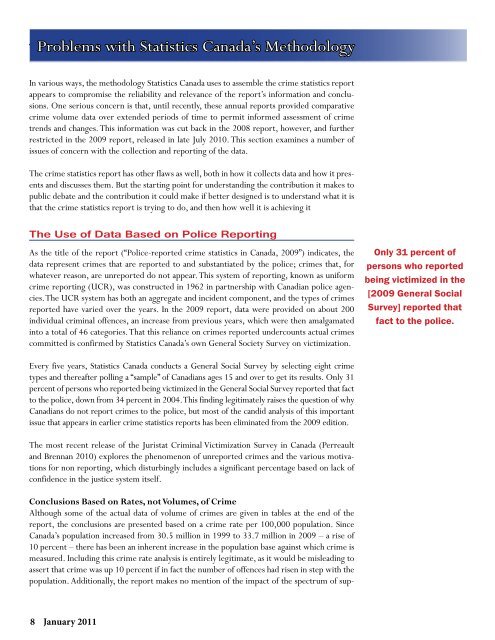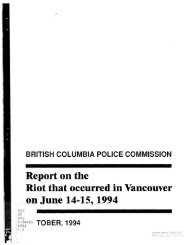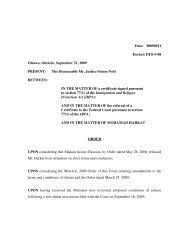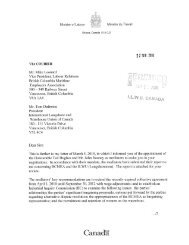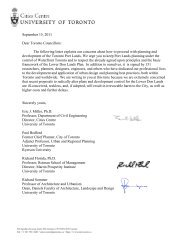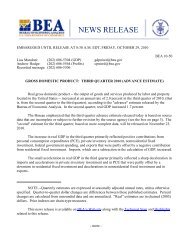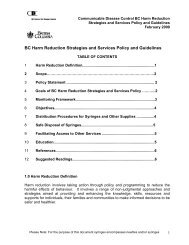Why Canadian crime statistics don't add up - The Globe and Mail
Why Canadian crime statistics don't add up - The Globe and Mail
Why Canadian crime statistics don't add up - The Globe and Mail
Create successful ePaper yourself
Turn your PDF publications into a flip-book with our unique Google optimized e-Paper software.
title Problems with Statistics Canada’s Methodology<br />
In various ways, the methodology Statistics Canada uses to assemble the <strong>crime</strong> <strong>statistics</strong> report<br />
appears to compromise the reliability <strong>and</strong> relevance of the report’s information <strong>and</strong> conclusions.<br />
One serious concern is that, until recently, these annual reports provided comparative<br />
<strong>crime</strong> volume data over extended periods of time to permit informed assessment of <strong>crime</strong><br />
trends <strong>and</strong> changes. This information was cut back in the 2008 report, however, <strong>and</strong> further<br />
restricted in the 2009 report, released in late July 2010. This section examines a number of<br />
issues of concern with the collection <strong>and</strong> reporting of the data.<br />
<strong>The</strong> <strong>crime</strong> <strong>statistics</strong> report has other flaws as well, both in how it collects data <strong>and</strong> how it presents<br />
<strong>and</strong> discusses them. But the starting point for underst<strong>and</strong>ing the contribution it makes to<br />
public debate <strong>and</strong> the contribution it could make if better designed is to underst<strong>and</strong> what it is<br />
that the <strong>crime</strong> <strong>statistics</strong> report is trying to do, <strong>and</strong> then how well it is achieving it<br />
<strong>The</strong> Use of Data Based on Police Reporting<br />
As the title of the report (“Police-reported <strong>crime</strong> <strong>statistics</strong> in Canada, 2009”) indicates, the<br />
data represent <strong>crime</strong>s that are reported to <strong>and</strong> substantiated by the police; <strong>crime</strong>s that, for<br />
whatever reason, are unreported do not appear. This system of reporting, known as uniform<br />
<strong>crime</strong> reporting (UCR), was constructed in 1962 in partnership with <strong>Canadian</strong> police agencies.<br />
<strong>The</strong> UCR system has both an aggregate <strong>and</strong> incident component, <strong>and</strong> the types of <strong>crime</strong>s<br />
reported have varied over the years. In the 2009 report, data were provided on about 200<br />
individual criminal offences, an increase from previous years, which were then amalgamated<br />
into a total of 46 categories. That this reliance on <strong>crime</strong>s reported undercounts actual <strong>crime</strong>s<br />
committed is confirmed by Statistics Canada’s own General Society Survey on victimization.<br />
Only 31 percent of<br />
persons who reported<br />
being victimized in the<br />
[2009 General Social<br />
Survey] reported that<br />
fact to the police.<br />
Every five years, Statistics Canada conducts a General Social Survey by selecting eight <strong>crime</strong><br />
types <strong>and</strong> thereafter polling a “sample” of <strong>Canadian</strong>s ages 15 <strong>and</strong> over to get its results. Only 31<br />
percent of persons who reported being victimized in the General Social Survey reported that fact<br />
to the police, down from 34 percent in 2004. This finding legitimately raises the question of why<br />
<strong>Canadian</strong>s do not report <strong>crime</strong>s to the police, but most of the c<strong>and</strong>id analysis of this important<br />
issue that appears in earlier <strong>crime</strong> <strong>statistics</strong> reports has been eliminated from the 2009 edition.<br />
<strong>The</strong> most recent release of the Juristat Criminal Victimization Survey in Canada (Perreault<br />
<strong>and</strong> Brennan 2010) explores the phenomenon of unreported <strong>crime</strong>s <strong>and</strong> the various motivations<br />
for non reporting, which disturbingly includes a significant percentage based on lack of<br />
confidence in the justice system itself.<br />
Conclusions Based on Rates, not Volumes, of Crime<br />
Although some of the actual data of volume of <strong>crime</strong>s are given in tables at the end of the<br />
report, the conclusions are presented based on a <strong>crime</strong> rate per 100,000 population. Since<br />
Canada’s population increased from 30.5 million in 1999 to 33.7 million in 2009 – a rise of<br />
10 percent – there has been an inherent increase in the population base against which <strong>crime</strong> is<br />
measured. Including this <strong>crime</strong> rate analysis is entirely legitimate, as it would be misleading to<br />
assert that <strong>crime</strong> was <strong>up</strong> 10 percent if in fact the number of offences had risen in step with the<br />
population. Additionally, the report makes no mention of the impact of the spectrum of s<strong>up</strong>-<br />
8 January 2011


